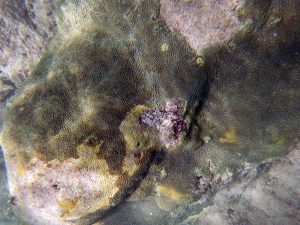
Healthy P. clivosa on the Reef Flat, Jan 15, 2024. Click on images for larger versions. More Pics
Large mounds of Pseudodiploria clivosa are common on the Reef Flat and Diploria-Palytoa zones at Vauxhall and can assume some quite striking, even majestic, forms.
I had not seen diseased Pseudodiploria clivosa amongst these big specimens at Vauxhall until I viewed this large specimen on the Reef Flat, Mar 10, 2024. It’s a large specimen, located about 1/3rd of the distance out from shore to the Reef Crest area. It has symptoms of Stony Coral Tissue Loss Disease (view AGGRA Card), “the most devastating coral disease outbreak ever recorded” (1).
 |
 |

Approx. route on Mar 10, 2024. , Asterisk shows location of diseased P clivosa
In studies of SCTLD, P clivosa has been cited as one of the Highly Susceptible (2) or More Susceptible species (3). While P. clivosa is an common coral at Vauxhall, most specimens I have viewed were disease free. In 2023, McGill students observed far fewer diseased specimens of P clivosa than they did for P. strigosa (4).
What makes particular coral species or particular specimens susceptible to SCTLD is not well understood (1). Perhaps there is resistance at the individual specimen level, perhaps not, or there may be interactions with other factors, e.g. heat stress (4).
It should be informative to monitor this Reef Flat population in future, fingers crossed!
Lit Cited
1.Stony coral tissue loss disease: a review of emergence, impacts, etiology, diagnostics, and intervention
E Papke et al., 2023 in Front. Mar. Sci., 25 January 2024
2. Case Definition: Stony Coral Tissue Loss Disease (SCTLD)
AGGRA 2018 Thier “Highly Susceptible Species” include P.clivosa
3. Stony coral tissue loss disease decimated Caribbean coral populations and reshaped reef functionality
Lorenzo Alvarez-Filip wt al., 2022 in Nature Communications. P clivosa cited as one of the more susceptible species (10% and > infected) in their survey
4. Occurrence of Stony Coral Tissue Loss Disease on Vauxhall Reef and a Breakwater in the Folkstone Marine Protected Area of Barbados
Keira Cassidy et al., 2023. Class Report McGill Geography 496
